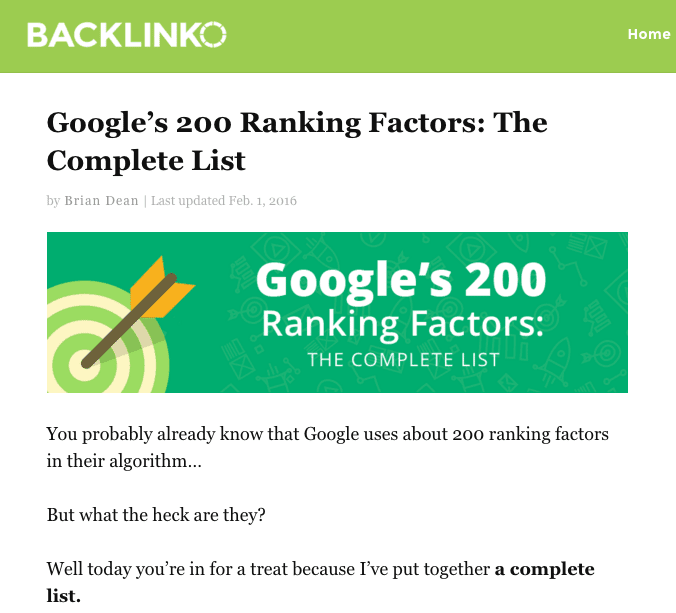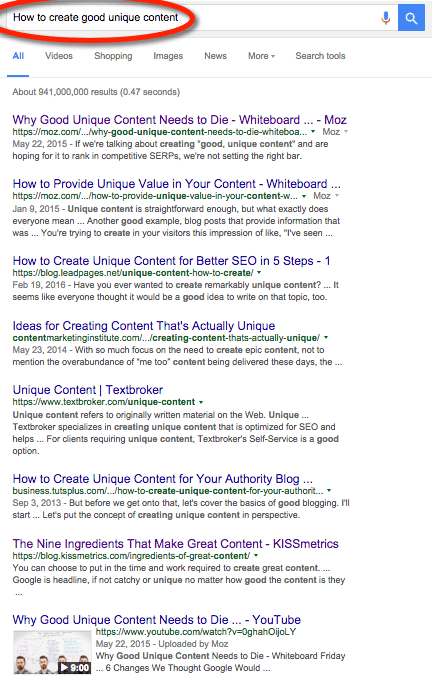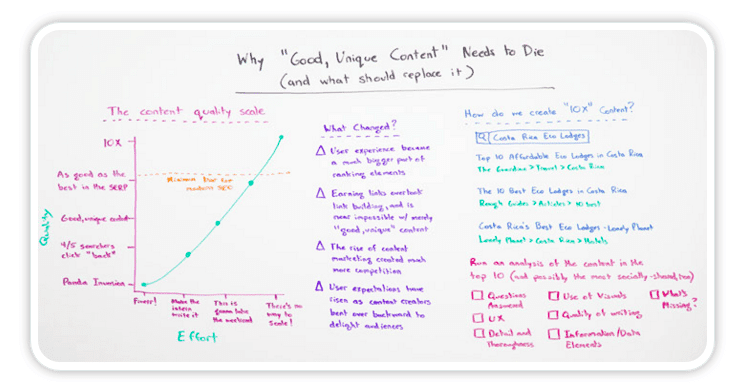This blog post is part of “The Ultimate Guide to Lead Generation” and “The Ultimate Guide to SEO” blog series.
You wrote a great article for your website. It reads like a Stephen King story. You’ve SEO’d it to the hilt–your keywords, page titles, H1s, alt tags, and meta descriptions are all aligned like Shirley McLaine. You’re ready to rank! But you don’t. You promote and promote on social media. You get backlinks. You get comments. Still on page 4 of the search engine results pages (SERPs).
What? You’ve created some good unique content, right? That’s what you’re supposed to do. It’s supposed to help you get found and rank high.
Sorry, but it doesn’t work any more.
Since the Panda/Penguin revolution, a common content marketing mantra has been to focus “good unique content.” This was in response to Google changing its ranking system, both algorithmic and human, to reward a good user experience more than simply measuring keywords and clicks and sending whatever page gets the most of either to the top of the SERPs.
Good unique content was supposed to be a way to trump SEO trickery in the post-Penguin/Panda era, because the goal is now to make searchers happy, not just capture their clicks.
So everyone created good unique content–so much that good content is no longer unique, and unique content is no longer good enough to rank. There’s just too damn much of it. Not only that, but you might be up against large, dominant voices who have the capacity to publish more, and from known authors.
In fact, SEO guru and Moz founder Rand Fishkin titled one of his “Whiteboard Friday” sessions, “Why Good Unique Content Needs to Die.” There’s nothing particularly wrong with good unique content, it’s just that it doesn’t work anymore. It is not good enough to stand out–not in today’s content-driven marketplace; and not when Google continues to refine and expand its user experience metrics to determine what constitutes content that is valuable to searchers.
Fishkin’s answer was that you must create content that is “10x better” than anything else out there in order to rise to SERP heaven. Great advice. But how?
Brian Dean of Backlinko fame spends months creating what he calls “Skyscraper” blogs–posts that cover topics in great detail, with many, many examples of how to do things like get quality backlinks and create articles that get hundreds of thousands of views, and that make the salesperson’s phone ring. He doesn’t just list resources you should check out to improve your performance. He shows you how to use them, and he shows you the months of work he has done and the results his work has produced. His blog posts are 10x better and more productive than dozens of 500 word blog posts with a few tips.
So, how do you and I make better content–much better than what’s out there? Let’s start by looking at an example of something that is already there.
How To Be Better
Let’s try a search on, “How to create good unique content.” Sorry, I couldn’t resist. Guess what comes up to the top? Rand Fishkin’s “Why Good Unique Content Needs to Die.” Makes sense that the Moz master has practiced what he preaches–creating something that is beyond good and unique–it is exceptional. Let’s dig in to see how.
First, the keywords are all in the right places. The page title, url, H1, and copy are all right there on the first page. You know you’ve gotten what you searched for, which makes Google really happy. But that’s the basics. What is 10x better than anything else?
1) Video – People love video. Google loves video. It’s harder to create a video than it is to write something. You need more time to script and produce a video. But it is much easier to watch a video, especially for a longer form piece, than it is to read through text. Videos are more memorable and convey emphases more readily than plain text.
2) Visuals – The whiteboard is well organized and helps Rand walk through the story that he’s telling. It serves as an infographic that helps the viewer better understand the content.
3) Questions are answered – It’s critical to answer the questions you’ve optimized around–in this case, how to create good unique content. Yes the visibility of the topic on the page is basic SEO, but it is also true that exceptional content makes it very easy for searchers to get what they are searching for–answers to their questions and solutions to their problems.
4) Clear recommendations – Searchers want answers, right? The video and text version give very specific advice for how to create content that is better than what’s out there.
It Takes Work
Rand Fishkin, Brian Dean, and other great content marketers work their tails off to create great content that people want to read and share. It’s not the kind of thing you can toss off in your spare time. Here are some of the recommendations they make:
1) Do your homework – Research what you want to rank for. See what else is out there. What’s missing? Video? Better graphics? More specific information?
2) Look for opportunities – If you search on a subject and there isn’t a lot of recent material ranking high, that may be a place where you can rank higher, faster. Look for ways to update out of date information (Brian Dean recommends contacting bloggers with out of date blogs and asking them to link to your update, generating valuable back links).
3) Stay focused – Your goal is not to entertain, but to help. Sometimes as writers, we can try a little too hard to be clever, which can distract users from getting what they want. Rand’s material is very serious. He doesn’t waste much time on irrelevant asides. Your goal is to help people get something done, fast.
4) Give examples – One of the things that Brian Dean does very well is show people how to do things, not tell them. He gives screenshots that show exactly what he and his clients have done, and then shows the actual results. This is harder than you might think, as some of his recommendations have taken some time to succeed. So he is constantly tracking is campaigns and documenting results for use in future articles.
5) Focus on what you do best – Look, Brian Dean and Rand Fishkin rank high because they’re writing about stuff they do very, very well. What do you do very, very well? Put differently, what do you do 10 times better than anyone else? That’s a starting point. Blog about how you do it, and how others can do it too.
6) Don’t gate it – As content marketers we’re trained to create content that generates leads, so we put our best stuff behind a landing page that requires a form fill. That’s not always the best approach. Leaving your best stuff ungated can generate much more traffic, and if it’s really helpful, more interest in learning more.
At the end of the day, Google and content marketers share the same goal. We want to help people get what they want as quickly and as easily as possible. Keeping this in mind can help us avoid some of the pitfalls of creating effective content. Stick to the point. Make it quickly. Don’t clutter your pages with irrelevant information or images. If you do this, you will be rewarded by Google and, more importantly, you’ll be rewarded by your readers, increasing the traffic, leads, ad revenue, or sales that you’re trying to get.
This blog post is part of “The Ultimate Guide to Lead Generation” blog series.








